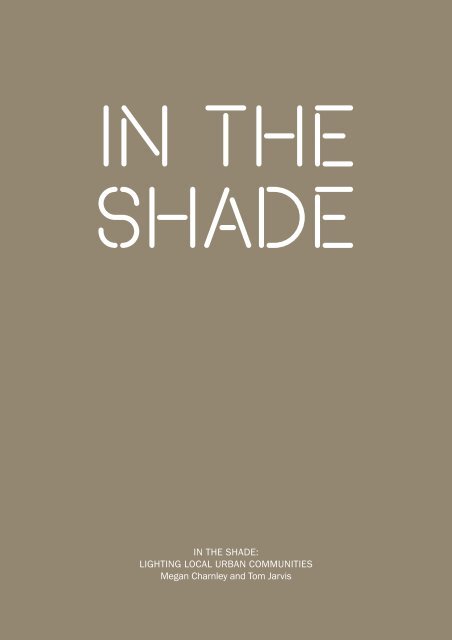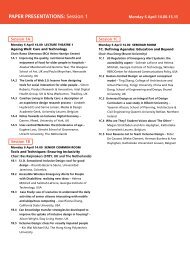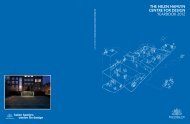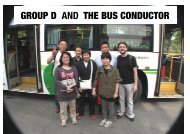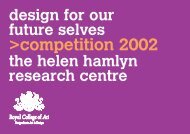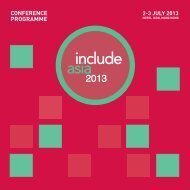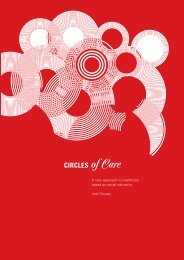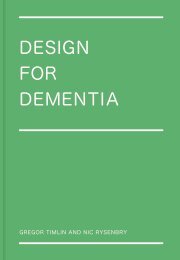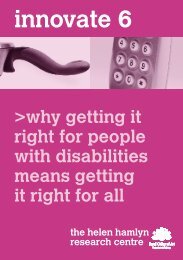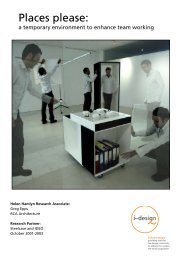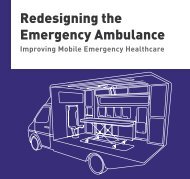Download In The Shade PDF here (3.8MB) - Helen Hamlyn Centre ...
Download In The Shade PDF here (3.8MB) - Helen Hamlyn Centre ...
Download In The Shade PDF here (3.8MB) - Helen Hamlyn Centre ...
Create successful ePaper yourself
Turn your PDF publications into a flip-book with our unique Google optimized e-Paper software.
IN THE SHADE:<br />
LIGHTING LOCAL URBAN COMMUNITIES<br />
Megan Charnley and Tom Jarvis
CONTENTS<br />
Foreword by Mark Major 2<br />
<strong>In</strong>troductions by Sharon Pang<br />
and Jeremy Myerson 4<br />
Context 7<br />
Research Methods 13<br />
Project Site 15<br />
Community Engagement 21<br />
Project Hypothesis 27<br />
Lighting Event 31<br />
Design Development 33<br />
Design Concept 37<br />
Design <strong>In</strong>stallation 41<br />
Conclusion 46<br />
About the Authors 47<br />
Bibliography 48
IN THE SHADE<br />
IN THE SHADE:<br />
LIGHTING LOCAL URBAN COMMUNITIES<br />
Megan Charnley and Tom Jarvis<br />
1
MARK CONTEXT MAJOR<br />
<strong>The</strong> importance of good lighting in the urban environment<br />
cannot be underestimated. Not only can it help us feel safe<br />
and secure but also make a significant contribution to social<br />
cohesion and economic progress.<br />
Ever since the industrialisation of light in Britain at the end<br />
of the 19th century we have always employed the very latest<br />
technology to help extend the day. Whilst this was initially<br />
done through limited but organised systems of gas lighting,<br />
the on-going development of electric light in the 20th century<br />
enabled us not only to illuminate all our streets but also<br />
buildings, bridges, monuments, landscaped areas, signs and<br />
billboards – the very fabric of our cities – and all on a grand<br />
scale. This has had the effect of making the public realm ever<br />
more visible and accessible after dark, profoundly changing<br />
the way we use both public and private space, particularly<br />
during the winter months.<br />
<strong>The</strong> rapid development of urban lighting has brought many<br />
positive benefits, but such change has come with<br />
consequences. Not only have we seen the skies become<br />
polluted with light, blocking out the view of night sky and<br />
creating unwanted impacts on bio-diversity, but with growing<br />
concerns about climate change lighting has come into<br />
sharp focus as a considerable consumer of energy. <strong>In</strong>deed<br />
the impact of ‘over-illumination’ is now under scrutiny and<br />
questions have begun to be asked as to why we need to<br />
use so much light and what the long-term effect will be on<br />
our wellbeing.<br />
<strong>The</strong> value of darkness is also in the process of being<br />
carefully reassessed. We have seen lighting used to great<br />
effect in our city centres, but the same cannot always be said<br />
for outlying districts and residential neighbourhoods w<strong>here</strong><br />
systemic under-investment and poor practice has resulted<br />
in a perception that the streets are not always a safe place<br />
to be after dark.<br />
With the shift from more traditional forms of electric lighting<br />
such as incandescent, fluorescent and discharge lighting<br />
to the solid-state world of light-emitting diodes (LEDs), the<br />
possibility of not only creating high quality public lighting<br />
whilst using considerably less energy but also better directing<br />
and controlling that light, offers new and exciting possibilities.<br />
To that end the research and development being carried out<br />
into this area by the RCA’s <strong>Helen</strong> <strong>Hamlyn</strong> <strong>Centre</strong> for Design<br />
and Megaman, as represented by this book, is most timely<br />
in that it addresses some very fundamental questions.<br />
How can light be used more progressively in the public realm,<br />
and in particular in our neighbourhoods How can we create<br />
a truly sustainable approach to lighting development in which<br />
we realise the social and economic benefits good lighting can<br />
bring whilst mitigating the environmental impacts How do<br />
we use rapidly advancing lighting technology to create new,<br />
exciting, useful and viable products that can help move us<br />
away from the purely functional delivery of light And how can<br />
we create a better understanding around the subject of light<br />
2
IN THE SHADE<br />
By addressing the issue of urban lighting in a truly holistic<br />
manner and choosing to focus on the problems of a specific<br />
area of London, Megan Charnley and Tom Jarvis have not only<br />
helped to address many of these questions but have done<br />
so through a system of proper community engagement. As<br />
a result they have not only given us a fascinating insight into<br />
the general issues surrounding this subject but have also<br />
exposed some of the prevailing attitudes towards both light<br />
and darkness in one of that city’s tougher neighbourhoods.<br />
<strong>The</strong>ir highly imaginative response goes well beyond the<br />
conventional approach, providing a new benchmark for<br />
progressive thinking about urban light and inviting us to carry<br />
out further investigation. Most importantly, however, they<br />
show us how we might make real progress through using light<br />
as a tool for creating proper places for people after dark.<br />
MARK MAJOR RIBA, IALD PLDA FRSA<br />
DIRECTOR AND FOUNDING PARTNER, SPEIRS + MAJOR<br />
3
SHARON CONTEXT PANG<br />
Lighting has a vital role to play in building and supporting<br />
urban communities that are sustainable – socially,<br />
environmentally and economically. This publication describes<br />
a design research project supported by the Megaman Charity<br />
Trust Fund that investigates the condition of poorly lit innercity<br />
areas – and designs and tests an innovative lighting<br />
solution on a local housing estate.<br />
This is the second project on which we have collaborated with<br />
the <strong>Helen</strong> <strong>Hamlyn</strong> <strong>Centre</strong> for Design at the Royal College of<br />
Art, London. <strong>The</strong> first, Light Volumes Dark Matters by Claudia<br />
Dutson, looked at over-illumination of commercial interiors;<br />
we are also planning a third study with the RCA to explore the<br />
future of lighting for learning environments.<br />
We greatly value our partnership with the <strong>Helen</strong> <strong>Hamlyn</strong><br />
<strong>Centre</strong> for Design as it encourages us to look at lighting from<br />
a broader social perspective. I have been impressed with the<br />
ability of architectural researcher Megan Charnley to reach<br />
out to community groups and with the expertise of industrial<br />
designer Tom Jarvis in developing Megan’s hypothesis for<br />
a Night-Time Neighbourhood Network into a working light<br />
system. Together they have produced a compelling publication<br />
that I hope will be widely read by those who design and<br />
commission urban lighting schemes.<br />
SHARON PANG<br />
MEGAMAN CHARITY TRUST FUND<br />
<strong>The</strong> Megaman Charity Trust Fund was established in February<br />
2008 to support programmes and projects specialising in<br />
education and environmental protection. Megaman is a<br />
leading designer, manufacturer and marketer of innovative<br />
lighting solutions and equipment. It is probably best known<br />
for its pioneering work on innovative designs of CFLs and<br />
LEDs that enable the replacement of less efficient light<br />
sources in a wide range of applications.<br />
4
JEREMY IN THE MYERSON SHADE<br />
Lighting design and its effect on individuals and communities<br />
has been a long-term research preoccupation of the<br />
<strong>Helen</strong> <strong>Hamlyn</strong> <strong>Centre</strong> for Design. That because light is so<br />
fundamental to our visual experience of the world and a major<br />
factor in determining quality of life.<br />
Our cities are now light-filled places but the distribution of<br />
lighting is uneven. If you’ve ever walked quickly at night from<br />
the reassurance of a brightly lit shopping street or business<br />
district to a poorly lit residential area or housing estate, which<br />
immediately fills you with a sense of foreboding as you move<br />
through it, then you’ll know what I’m talking about.<br />
<strong>In</strong> the <strong>Shade</strong> not only demonstrates how light – or lack of<br />
it – can be a divisive issue in residential areas that are shared<br />
by diverse communities but also points to a future in which<br />
new lighting technology can integrate more flexibly with<br />
urban infrastructure. I am grateful to the Megaman Charity<br />
Trust Fund in Hong Kong and to Paviom in the UK for their<br />
support in enabling us to explore the challenges of making<br />
cities more sustainable.<br />
JEREMY MYERSON<br />
HELEN HAMLYN CENTRE FOR DESIGN,<br />
ROYAL COLLEGE OF ART<br />
Such a transition can be made between the well-heeled<br />
City of London and the historic Boundary Estate just a stone’s<br />
throw away. <strong>The</strong> change in lighting reflects the inequalities<br />
between very different communities. <strong>The</strong> Boundary Estate<br />
is the setting for the design project, <strong>In</strong> the <strong>Shade</strong>, described<br />
in this publication. But, as researchers Megan Charnley and<br />
Tom Jarvis point out, it is also a proxy for overlooked and<br />
under-lit inner-city communities all over the UK.<br />
5
CONTEXT<br />
6
IN THE SHADE<br />
THE PROBLEM OF UNEVEN LIGHT DISTRIBUTION<br />
As cities around the world compete for inward investment<br />
from tourism and business, t<strong>here</strong> has been much focus on<br />
lighting public spaces, both indoors and out. Much of that<br />
investment has gone into illuminating popular tourist areas,<br />
heritage buildings and the commercial districts of the city.<br />
As a result, urban lighting is unevenly distributed.<br />
While some areas are so brightly lit that the environment<br />
suffers from light pollution, many pockets of the city remain<br />
underlit at night. This limits local trade and use of public<br />
space, undermining economic activity and social cohesion,<br />
and leaving local communities literally and metaphorically<br />
in the dark.<br />
This project set out to explore how a new lighting design<br />
strategy for these overlooked pockets of the urban fabric<br />
could help to create more sustainable cities. <strong>The</strong> research<br />
examines the possibilities for intelligent, energy-efficient<br />
lighting as a catalyst for the creation of more socially resilient<br />
and economically viable urban areas after dark, in which<br />
community ties are strengthened and new fields of possibility<br />
are opened to a wider group of residents.<br />
By fundamentally rethinking how we light spaces, and by<br />
looking to balance energy efficiency with a sense of identity,<br />
we wanted to contribute to the formation of a new approach<br />
to sustainable lighting, w<strong>here</strong> sustainability is understood<br />
comprehensively to include environmental, economic and<br />
social factors.<br />
By reviewing the current conditions of the city at night,<br />
establishing a hypothesis about how this condition can –<br />
realistically – be improved, and then testing that hypothesis<br />
in the urban environment, we aimed to show that moves<br />
towards a more sustainable night-time city do not<br />
necessarily require massive investment, radical technology<br />
or new urban infrastructures.<br />
This is a proposal for a new way to light the night-time city,<br />
set in the context of the ambition of cities to move towards<br />
a lower-carbon economy.<br />
7
CONTEXT<br />
SOCIAL SUSTAINABILITY AND PLACEMAKING<br />
<strong>In</strong> contemporary lighting design, the ability of light to<br />
generate or reinforce a sense of place has become almost<br />
as important as its fundamental role in making objects<br />
visible. As an element that is crucial to placemaking – the<br />
creation of a unique and recognisable character for a part<br />
of the city – lighting is recognised as a powerful tool.<br />
<strong>In</strong> order to make a place that appeals to residents and<br />
visitors alike, it is hugely important that the local community<br />
should use and enjoy it. Social activity is what makes a space<br />
attractive. While placemaking is now an established part<br />
of any urban regeneration, and a lighting strategy will usually<br />
be submitted at the proposal stage, little real consideration<br />
is given to how these areas are used after dark. <strong>The</strong> city<br />
at night is an overlooked – and under-exploited – territory.<br />
Despite the static nature of most lighting strategies, lighting<br />
the public realm is no longer simply about relieving the<br />
darkness. As urban designer Alex Cochrane notes: ‘Modern<br />
society has become fascinated with event culture and the<br />
visual spectacle.’ Lighting design is integral to this. Not only<br />
must lighting now be permanent, well rendered and carefully<br />
considered, but it should also enable a wide range of different<br />
uses. For a vibrant daytime area to be as welcoming at night,<br />
lighting must enable and encourage social interaction according<br />
to the ever-changing requirements of the inhabitants.<br />
However a change towards a more public urban life seems<br />
to be developing fast in British culture – and with it, the idea<br />
of the public realm at night as an extension of leisure space.<br />
Good lighting design has the potential to expand urban design<br />
as placemaking into the British night-time. <strong>The</strong> city at night<br />
is a different environment from the city in the daytime; a new<br />
realm of opportunity is opened for urban and lighting<br />
designers in recognising its different roles and meeting its<br />
diverse demands.<br />
Part of what differentiates the night-time city from the daytime<br />
city is a very strong set of cultural norms and ideas held<br />
about the city at night. <strong>The</strong>re is a sense – much more firmly<br />
ingrained in the British sensibility than in the European one<br />
– that the city at night is intrinsically bad. It is simultaneously<br />
a place of fun and frivolity and a dark destination for vice.<br />
And the irrational sense of danger that surrounds the city at<br />
night makes it out of bounds for certain groups in the urban<br />
community, such as families, women and older people.<br />
If the city at night is to be a real public space, then it must<br />
be made accessible to all sectors of society. Lighting clearly<br />
has a role to play in making socially sustainable places.<br />
<strong>The</strong> development of an event-focused culture and the<br />
growth of the 24-hour city in the UK has interesting potential<br />
consequences. London has often been considered an<br />
introverted city; according to one observer in 1989, in London,<br />
‘the life of leisure withdrew more and more from the street<br />
into private spaces and closed societies’, leaving the<br />
impression that ‘in comparison to other world cities London<br />
has only a very limited social life’.<br />
8
IN THE SHADE<br />
9
CONTEXT<br />
10
IN THE SHADE<br />
Broken Light Project by Rudolf Teunissen. Luminaires create light columns<br />
and patterns on a street in Rotterdam, radically changing the feel of this<br />
once ignored district. Photo: Hans Wilschut<br />
THE ROLE OF LIGHTING<br />
Numerous social studies, as well as extensive anecdotal<br />
evidence, show that women and older people in particular<br />
tend to avoid city areas at night. To make a place that feels<br />
safe, more people must be encouraged to spend time t<strong>here</strong>.<br />
By making public spaces more enjoyable, more people will<br />
occupy them, and they will seem less threatening. <strong>In</strong> this way,<br />
lighting has a crucial role to play in the creation of a more<br />
inclusive urban public life.<br />
Although much current lighting practice is focused on<br />
advertising, traffic and crime prevention, the broader social<br />
and economic potential of lighting is recognised in British<br />
lighting standards. British Standard 5489-1:2003 states that<br />
‘a function of lighting in urban centres, in addition to that<br />
of general safety and security, is to enhance the night-time<br />
environment. <strong>The</strong> provision of appropriate and attractive<br />
lighting can assist in stimulating trade and commerce’;<br />
lighting should also ‘attempt to encourage people to visit<br />
and make use of the facilities’.<br />
But while social opportunities opened up by good urban<br />
lighting may be acknowledged in lighting standards, our<br />
explorations of certain pockets of the city revealed little<br />
evidence to suggest that local authorities consider this<br />
function a priority. Almost everyw<strong>here</strong>, vehicular traffic,<br />
commercial interests and the requirements of CCTV and<br />
crime prevention seem to dictate lighting policy.<br />
After initial research, we concluded that to create a successful<br />
night-time urban realm that can be economically and socially<br />
sustainable, lighting design should:<br />
• create well lit (but not necessarily bright) spaces to be<br />
used by the people who live in the city – rather than spaces<br />
designed mainly to be attractive to visitors;<br />
• engage with communities to engender a sense of belonging<br />
and civic pride;<br />
• consider the potential for changes to the lighting conditions<br />
(for example for a special event) and be adaptable to meet<br />
different requirements;<br />
• encourage the use of outdoor space at night by local<br />
communities;<br />
• challenge lighting codes and guidelines, which can be<br />
outdated and over-specify high levels of light;<br />
• recognise that it is the quality of the lit environment that<br />
affects fear of crime, not simply the quantity of lux levels;<br />
• design in shadows as part of the lighting strategy – the<br />
intensity and layering of shadow can be just as important<br />
in creating a sense of place as the levels of light.<br />
11
RESEARCH METHODS<br />
12
IN THE SHADE<br />
OVERVIEW<br />
“A lot of the learning to work with light, since it doesn’t<br />
form by working with the hands as clay does, is this<br />
working with light through thoughts”.<br />
— James Turrell, Artist<br />
Although the world of lighting design has long been defined<br />
by strict codes and light level recommendations, our view<br />
is that lighting in the public realm is too diverse and complex<br />
to be successfully categorised empirically.<br />
A row of flickering gas lights under a moonless midnight sky<br />
in Hyde Park can seem as bright to the adaptable human eye<br />
as a garish LED screen in an over-lit shopping street; apparent<br />
quality and quantity of light entirely depends on the context.<br />
So we set out to assess existing lighting strategies to<br />
establish how light can influence and redefine the city, before<br />
selecting a site on which to explore the effect of specific<br />
lighting conditions.<br />
<strong>The</strong> research can be divided into two strands: investigation,<br />
which included a literature search, review of lighting<br />
technology, conferences, expert interviews, user workshops<br />
and community engagement; and exploration, which included<br />
walking and mapping the city, subjective analysis of lighting<br />
conditions, comparative studies, and concept development<br />
and testing of a new prototype lighting system.<br />
Lighting design and the public realm covers a vast territory.<br />
Several mapping exercises were undertaken to navigate<br />
through it. <strong>The</strong>se helped differentiate lighting for security,<br />
sustainability, identity, regeneration and community.<br />
Early in the study, in order to filter new knowledge and focus the<br />
research, we looked for a compact urban site in London that<br />
we could analyse in detail – a site with local communities with<br />
whom we could engage in order to test our hypothesis about<br />
the social and economic impact of better lighting after dark. Our<br />
choice of site was the Boundary Estate in East London.<br />
13
PROJECT SITE<br />
14
IN THE SHADE<br />
THE HISTORIC BOUNDARY ESTATE<br />
<strong>In</strong> order to understand better how pockets of the city are used<br />
at night, on-site research was crucial. <strong>The</strong> historic Boundary<br />
Estate in Shoreditch, East London, is particularly interesting<br />
as a research site. As London’s first council estate situated in<br />
a rapidly changing part of the city, tensions between different<br />
groups of residents arise – especially at night. <strong>The</strong> Boundary<br />
Estate was chosen as the primary site for the study.<br />
Although this regeneration was ostensibly carried out for<br />
the residents of the Old Nichol, very few could actually afford<br />
to live in the new flats, and almost all of them were forced to<br />
relocate out of the area. This was the first of many population<br />
shifts on the site.<br />
Its history is fascinating. <strong>In</strong> 1890 London County Council<br />
embarked on a slum clearance programme to clear the site<br />
of the famous Old Nichol in Shoreditch, East London – the<br />
setting for Jasper Morrison’s novel, A Child of the Jago. On this<br />
site, between 1892 and 1899 the London Metropolitan Board<br />
of Works built the Boundary Estate – the first housing estate<br />
project in the UK 1 , which was officially ‘opened’ by the Prince<br />
of Wales in 1901. Arnold Circus, a raised, three-tiered garden,<br />
stands in the middle of the site, built from the rubble of the<br />
existing slum. A bandstand was erected in the centre in 1910,<br />
and still stands today.<br />
1 Single blocks had previously been built by state and charitable bodies<br />
such as Peabody, but no estate had been built by a local authority until<br />
the Boundary Estate<br />
15
PROJECT SITE<br />
THE BOUNDARY ESTATE TODAY<br />
<strong>The</strong> Boundary Estate today has a diverse community including<br />
a high percentage of British Bengali families. With an unusual<br />
raised circular garden at its centre, the estate has one of the<br />
few well-loved public gardens in the densely populated East<br />
End – a garden that has been revived over the past ten years<br />
by an increasingly engaged middle-class community.<br />
<strong>The</strong> site is adjacent to the financial district and amidst one<br />
of London’s busiest nightlife areas, yet it is a residential estate<br />
and within a conservation area. <strong>The</strong>re are various tensions<br />
within the diverse community, which are compounded by the<br />
influx of partygoers in the short term and wealthy City workers<br />
in the long term.<br />
<strong>The</strong> different communities use the area differently. At night,<br />
the estate’s public realm is not a viable public space for some<br />
groups within the community – most notably older people,<br />
Bangladeshi women and girls – partly due to cultural norms,<br />
and partly due to a fear of crime. <strong>The</strong>re is a high awareness<br />
of street crime, especially drug dealing and prostitution, and<br />
a real fear of violence (despite relatively low levels of violent<br />
crime) that discourages many people from leaving their<br />
homes after dark.<br />
<strong>The</strong>re is a primary school at the centre of the estate – in the<br />
winter it can be dark when parents (predominantly mothers)<br />
collect their children after school. Despite the high percentage<br />
of young people and children attending school and living on<br />
the estate, children are rarely seen playing out of doors in<br />
the evening.<br />
<strong>The</strong> estate’s central garden – Arnold Circus – was renovated<br />
in 2005. As part of the works, new street lighting was installed,<br />
but this is aimed primarily at the needs of CCTV cameras<br />
rather than people. <strong>The</strong>re is enthusiasm for improving the<br />
estate’s lighting from the community who recognise that good<br />
lighting has the potential to encourage more participation<br />
in the urban realm; it could also help to eliminate anti-social<br />
behaviour and so improve the perception and use of the area.<br />
Many of these issues affect similar sites across the UK. Our<br />
research aimed to provide lighting strategies that are not only<br />
useful on the Boundary Estate but also applicable to many<br />
other under-lit urban estates. Enthusiasm for change from<br />
the most active members of the Boundary Estate community<br />
meant this site was particularly pertinent to investigate.<br />
16
IN THE SHADE<br />
17
PROJECT SITE<br />
THE BOUNDARY ESTATE: LIGHT SURVEY<br />
Despite many changes, the residents of the Boundary Estate<br />
are still predominantly council tenants, although many of the<br />
flats are now privately owned. By 2004 the public spaces of<br />
the historic Boundary Estate had fallen into disrepair. Arnold<br />
Circus, at the heart of the estate, was seen as a dirty and<br />
threatening place, with drug dealers and prostitutes swarming<br />
the area after dark. To counter anti-social behaviour on the<br />
site, the council’s proposition was to cut down all the trees<br />
on the Circus and replace them with floodlights.<br />
Appalled by the proposition, a small group of local people<br />
formed the Friends of Arnold Circus – a charity – and set<br />
about the rescue of this unique part of the East End’s<br />
heritage, aiming to re-establish it as a resource for all.<br />
Today, the Boundary Estate – with its unusual tall brick<br />
buildings, its verdant garden with still-standing plane trees,<br />
and its decreased crime rate – has improved dramatically.<br />
Yet it shares the same pressures as every other East<br />
London estate.<br />
Overcrowded flats provide little privacy to younger members<br />
of the community, who are forced to spend their free time<br />
outside with little to do, leaving them vulnerable to the many<br />
temptations of the city. <strong>The</strong>se young people are viewed by<br />
many residents as a threatening presence on the streets,<br />
however innocent their activity.<br />
<strong>The</strong>re are numerous public spaces around the estate,<br />
but after dark the lighting does little to encourage their use.<br />
Outside Clifton House, for example, is a small residential<br />
square visible from two roads leading to the Circus that<br />
would suit a number of quiet activities after dark, despite<br />
its decaying facilities and uneven terrain.<br />
<strong>The</strong> Arnold Circus bandstand is a recently restored and listed<br />
social area, raised at the centre of the estate. Unfortunately<br />
the 12 benches surrounding the bandstand are in the dark,<br />
a few lit only by the glare of a floodlight necessary for CCTV<br />
cameras to operate. And the self-contained Old Nichol Street<br />
playground is more popular at night for drug dealing than for<br />
playing according to locals, although it is well placed as the<br />
focal point for neighbouring flats.<br />
Across Tower Hamlets – the borough in which the Boundary<br />
Estate lies – t<strong>here</strong> are several traces of generous investment<br />
in public space. Within the estate itself, t<strong>here</strong> are four fully<br />
furnished playgrounds, all of which are abandoned. Not all<br />
of these failures can be attributed to poor or nonexistent<br />
lighting, but it is clear that without sufficient illumination the<br />
short winter days render these costly investments useless.<br />
<strong>The</strong> decline of these valuable facilities becomes a slippery<br />
slope. When properly lit, these areas are a welcoming asset<br />
to a community, providing a safe place to play for local children<br />
and their families. But when the lighting fails, these dark,<br />
sheltered spaces become the territory of drug dealers and<br />
sex workers.<br />
Evidence from schemes within Tower Hamlets suggests<br />
that the problem in providing decent local lighting is not<br />
purely financial. An approach to lighting that is abstracted<br />
from the real needs of residents, combined with a lack of<br />
suitable luminaire designs, has simply resulted in lighting<br />
that is unsuited to this demanding urban environment.<br />
18
IN THE SHADE<br />
19
COMMUNITY ENGAGEMENT<br />
20
IN THE SHADE<br />
A DIVERSE COMMUNITY<br />
Despite its proximity to the financial heart of the capital,<br />
the Boundary Estate actually borders the two most deprived<br />
areas of London. As with many similar areas around the<br />
world, the conjunction of wealth and poverty inevitably leads<br />
to tension.<br />
<strong>The</strong> Boundary Estate has a varied community. Parts of this<br />
community are very active, but the area as a whole suffers<br />
from what appears to be a cultural divide. <strong>The</strong>re are three<br />
main groups residing in the area: East Londoners, mainly<br />
older people who can trace their family history back many<br />
generations; Bangladeshi and British Bangladeshi families<br />
who have lived in East London for several generations and<br />
maintain a strong Bengali culture; and the professionals<br />
and artists who have moved into the area more recently.<br />
To understand how the estate is used by the community<br />
at night, we investigated across a spectrum of gender, age<br />
and culture. We were particularly interested in how a lighting<br />
strategy could potentially enable participation by those who<br />
are often excluded from public spaces at night (for security,<br />
cultural or mobility reasons) and whether exclusion was self<br />
imposed or otherwise.<br />
Our guides included Doris, 79, who grew up on the Boundary<br />
Estate, has lived in the area all her life and no longer leaves<br />
her home after dark; the Bandstand Boys, a group of young<br />
men in their late teens and early twenties who hang around<br />
the bandstand in the evening and have written to the council<br />
to request floodlighting for the local football pitch so that they<br />
can play after dark; and the Boundary Women’s Project, a<br />
dynamic group of predominantly Bengali British mothers with<br />
young children who meet at St Hilda’s Community <strong>Centre</strong>.<br />
<strong>The</strong>re is some tension between these groups, especially<br />
towards recent incomers who are held responsible for the<br />
dramatic changes in the area over the last decade.<br />
21
COMMUNITY ENGAGEMENT<br />
CITIZEN WORKSHOPS<br />
We held several workshops at St Hilda’s East community<br />
centre to include groups from the Boundary Estate: the<br />
Boundary Women’s Project, the Older People’s Group and<br />
the Bengali Men’s Project. Each session followed the same<br />
basic format, amended or adjusted to suit the specific<br />
requirements of each group.<br />
<strong>The</strong> aim of the workshops was to find out how people use<br />
urban space after dark and how they feel about it. Word<br />
association games, discussions and mapping exercises<br />
opened up ideas about the estate at night, including the types<br />
of people who are present. Participants were asked to draw<br />
or describe the area at night, identifying emotional as well<br />
as physical landmarks. <strong>The</strong>y drew negative aspects (such<br />
as dog fouling, noisy clubs, drug dealers) as well as positive<br />
ones (the gardens, delicious curry smells, their homes).<br />
<strong>The</strong> final part of the workshop was an imaginative challenge.<br />
<strong>The</strong> groups were asked: if Arnold Circus was a room in their<br />
house, which room would it be and why <strong>The</strong>y were also<br />
invited to complete a drawing of a lamp post to indicate what<br />
they would like a lamp post to do if anything were possible<br />
(for example, charge up electric cars or give directions).<br />
WHAT WE DISCOVERED<br />
<strong>The</strong> workshops generated a number of significant findings:<br />
• <strong>The</strong> Bengali men and the elderly group were very concerned<br />
about violence and muggings on the streets at night,<br />
to the extent that they rarely left their houses after dark<br />
– members of the women’s group were more concerned<br />
about the clubbers from the party scene in Shoreditch<br />
• <strong>The</strong> division between the Bangladeshi community and the<br />
‘uber trendy’ white community was so distinct in the minds<br />
of the women that in one instance it was charted on a map,<br />
indicating a clear set of territories<br />
• <strong>The</strong>re was consensus on w<strong>here</strong> bad things happen on the<br />
estate – these locations were widely known and avoided –<br />
and a general concern about sex workers and drug addicts<br />
in the area<br />
• <strong>The</strong> diversity of the area and the proliferation of restaurants<br />
were seen as positive features by the Boundary Women’s<br />
Group in particular<br />
• <strong>The</strong>re was general agreement that t<strong>here</strong> needs to be more<br />
considered lighting on the estate<br />
• <strong>The</strong> primary concern was with safety and security.<br />
<strong>The</strong> insights from the workshops were mapped to create<br />
a picture of the emotional and physical geography of the<br />
site at night. This was then used to identify potential sites<br />
for improved lighting.<br />
Comments about light that were made during the workshops<br />
were analysed in detail and categorized with reference to<br />
either the social environment or built environment at night.<br />
It was interesting to discover that most of the comments<br />
referred to the social environment – this supported a working<br />
hypothesis that the social environment is as important<br />
to creating a sustainable night-time city as factors relating<br />
to the built environment.<br />
Through our engagement with the community, through<br />
interviews, readings of reports and exploration of the estate<br />
after dark, it became clear that much of the locality is<br />
dominated by – or perceived to be dominated by – gangs of<br />
threatening youths. <strong>The</strong>ir presence discourages other people<br />
(especially women and older people) from using<br />
these spaces after dark.<br />
22
IN THE SHADE<br />
23
COMMUNITY ENGAGEMENT<br />
24
IN THE SHADE<br />
25
PROJECT HYPOTHESIS<br />
26
IN THE SHADE<br />
NIGHT-TIME NEIGHBOURHOOD NETWORK<br />
<strong>The</strong> Night-Time Neighbourhood Network is a proposal for a<br />
lighting framework that could open up paths through a darker<br />
city consuming less energy, via well-lit nodes of activity and<br />
participation.<br />
Fear of going out alone after dark has a huge impact on<br />
people’s lives in terms of the ability to engage in employment,<br />
adult education, civic and community participation and social<br />
and leisure activities.<br />
Between these well-lit public spaces, the street lights could<br />
be dimmed, saving energy and money and reducing glare.<br />
<strong>The</strong> proposed nodes would encourage a heightened sense<br />
of natural surveillance and benign or friendly occupation,<br />
rather than the current situation with the harsh glare of<br />
security lighting.<br />
<strong>The</strong>se nodes could be located at important points in the<br />
urban landscape – at amenities such as playgrounds or<br />
benches or at transport interchanges such as bus stops.<br />
<strong>The</strong> public realm after dark could provide opportunities<br />
for the Boundary Estate’s diverse communities to come<br />
together. <strong>In</strong>stead the poor social environment of the evening<br />
restricts access to local facilities, shops and public spaces<br />
for many in the community, especially the elderly, women and<br />
Bangladeshi men. This in turn has a negative impact on the<br />
local economy, especially in the dark winter months.<br />
<strong>The</strong> Night-Time Neighbourhood Network (NNN) would create<br />
a local network of brightly lit nodes in an area, each node<br />
visible to the next, inviting and encouraging social interaction<br />
at key points throughout the neighbourhood. All members<br />
of the community would be encouraged to use these well-lit<br />
spaces and interact with their neighbours, fostering a sense<br />
of community.<br />
27
PROJECT HYPOTHESIS<br />
THE GREAT BALLOON SWAP<br />
<strong>In</strong> order to test this hypothesis, a temporary lighting event<br />
was planned as an example of how a new node in the Night-<br />
Time Neighbourhood Network might be inaugurated and how<br />
a community might be drawn together after dark.<br />
This event, the Great Balloon Swap, was devised to announce<br />
a hypothetical lighting node at Arnold Circus, the circular<br />
bandstand and gardens at the centre of the Boundary Estate.<br />
Following community consultation, it was decided to create<br />
the event with coloured LED balloons.<br />
<strong>The</strong> event was planned as a prelude to the annual Arnold<br />
Circus Swap and Share Picnic – a community party to which<br />
everybody is encouraged to bring food, drink and skills to<br />
swap and share. <strong>The</strong> idea was to hand out balloons on the<br />
bandstand in the early evening to residents and passers by.<br />
<strong>The</strong> balloons were all white and secured by white ribbon.<br />
<strong>In</strong>side each balloon was a single coloured LED.<br />
<strong>In</strong> exchange for the balloon, participants were asked to draw<br />
their own face on it and have their picture taken to capture<br />
the diversity of the community. Participants were then asked<br />
to read eight statements about the city at night, which had<br />
been put up around the eight sides of the bandstand, and<br />
attach their balloon to the one they most agreed with. <strong>The</strong><br />
statements read: ‘<strong>The</strong> city at night is for....dancing / sleeping /<br />
drinking / walking / working / chatting / reading / shopping…’<br />
28
IN THE SHADE<br />
29
LIGHTING EVENT<br />
30
IN THE SHADE<br />
LOCAL LIGHT NODE<br />
Participants in the temporary lighting event at Arnold Circus<br />
were encouraged to swap their balloons with each other.<br />
<strong>The</strong> gradual build-up of balloons tied to the bandstand<br />
attracted more and more participants and as dusk fell at<br />
about 9pm, the LEDs were switched on and the bandstand<br />
was lit up dramatically.<br />
As the evening progressed, the bandstand became a lively<br />
graph of how people wanted to use their city in the evening<br />
– dancing and chatting quickly emerged as more popular<br />
activities than reading and sleeping.<br />
Residents and children came out to see what was going<br />
on; clubbers on their way to the bars of Shoreditch stopped<br />
to take part; a group of boys – often considered so<br />
threatening when they hang out at the gloomy bandstand<br />
– enthusiastically illustrated the balloons; dog-walkers and<br />
smokers stopped and lingered at the bandstand as the<br />
night fell and the balloons started to glow.<br />
Coloured spotlights kindly lent to the event by Paviom<br />
flooded the surface of the gardens and the bandstand at the<br />
centre of the estate became a lantern animated by the faces<br />
of the community.<br />
<strong>The</strong> experiment successfully demonstrated how to create<br />
a brightly lit node of social participation within a darker<br />
environment. <strong>In</strong> doing so, it suggested that the solution to<br />
under-lit urban areas is not simply to increase lighting levels<br />
to match those of the city’s commercial districts and tourist<br />
attractions.<br />
<strong>In</strong>stead, the darkness of the night can be respected and<br />
enjoyed – and the area can be made to feel safer and more<br />
attractive at night – by instigating a light skeleton or network<br />
of illuminated local amenities and infrastructures.<br />
<strong>The</strong> Great Balloon Swap helped us understand how the Night-<br />
Time Neighbourhood Network might work, by responding<br />
directly to the existing conditions of each locality. <strong>The</strong><br />
nodes in the lighting network would act both as way finding<br />
points and as secure rest spaces in each area, w<strong>here</strong> an<br />
increased footfall and social interaction might provide natural<br />
surveillance in place of CCTV.<br />
31
DESIGN DEVELOPMENT<br />
32
IN THE SHADE<br />
DEFINING THE BRIEF<br />
Following community research and on-site investigation,<br />
the project aimed to take direct action to improve the estate<br />
after dark by developing and prototyping a new lighting<br />
system. <strong>The</strong> Great Balloon Swap showed that a lighting event<br />
could create a temporary node that brings together a diverse<br />
population; the next step was to test a more permanent<br />
installation.<br />
We decided that the most valuable output would be a<br />
lighting kit to provide the flexibility and sensibility that most<br />
contemporary urban lighting masterplans do not – a versatile<br />
set of parts to enable councils and local communities to<br />
collaborate in lighting key facilities for use after dark.<br />
<strong>In</strong> response to these findings, we devised a brief to design<br />
a new system of urban lighting, covering the design of the<br />
hardware, the technology to monitor and adapt the light, and<br />
the means to implement such a lighting system. <strong>The</strong> brief can<br />
be summarised as follows:<br />
• To develop a flexible luminaire ‘kit’ that will facilitate diverse<br />
activities and adapt to a range of environments<br />
• To equip the lighting system with technology that enables<br />
it to acknowledge environmental factors such as human<br />
presence, existing light and time of day<br />
• To develop a way to distribute and maintain the luminaires<br />
that promotes communal ownership and responsibility.<br />
Key findings from the on-site research helped to shape the<br />
design brief. We took note that a well-lit facility can transform<br />
an area that is avoided at night into one full of activity; groups<br />
engaging in social activities can provide reassurance for<br />
residents; and the blanket coverage of street lighting ignores<br />
the character of spaces and can actually discourage people<br />
from venturing outdoors after dark.<br />
This lit steel staircase at a London underground station is assembled from a<br />
kit of parts. An example of lighting integrated into urban infrastructure.<br />
33
DESIGN DEVELOPMENT<br />
TUBULAR INFRASTRUCTURE<br />
A study of the local vernacular in and around the Boundary<br />
Estate revealed a popular construction method widely used<br />
in the public realm: scaffold tubes and clamps. <strong>In</strong> fact, these<br />
elements are so widespread throughout the city that they<br />
almost become invisible.<br />
Tubes are commonly employed to construct facilities such<br />
as handrails, bike racks, garden delineators, gates, fences,<br />
barriers, notice boards and many other pedestrian-scale<br />
public facilities. As a tool to impact the urban realm, these<br />
tubes have enormous potential given all the places across<br />
the city in which they are installed.<br />
Tube clamps are a common solution for the construction<br />
of tubular structures. A tube clamp system securely joins<br />
standard sizes of structural steel tube into almost any<br />
configuration imaginable. <strong>The</strong>se clamps require no welding,<br />
threading or bending – so no ‘hot-work’ permits or special<br />
tools are required – and they are the most popular means<br />
of constructing with tubes.<br />
Tube clamps are a flexible system that can accommodate<br />
site variations and do not require specialist labour. Local<br />
authorities are especially familiar with this means of<br />
construction and many stock their own library of parts.<br />
Tube clamps are generally made from galvanised cast iron<br />
but versions are available in aluminium.<br />
Tube clamps and scaffolding have become increasingly<br />
popular in recent years, with contemporary applications<br />
ranging from furniture and shop fittings to sports equipment<br />
and outdoor shelters. All of these factors indicate that tubes<br />
and clamps might make the ideal tools for implementing<br />
a new lighting strategy in urban areas.<br />
34
IN THE SHADE<br />
35
DESIGN IN THE CONCEPT SHADE<br />
Tube length and window arrangement<br />
Possible setups<br />
36
IN THE SHADE<br />
MAKING LIGHT TUBES<br />
By adapting a standard scaffolding tube to house an LED<br />
strip, the extensive library of tubes and clamps becomes<br />
a toolbox with which many permanent luminaire set-ups can<br />
be designed. It is a versatile system with vast potential –<br />
light tubes of varying lengths can be designed in such a way<br />
as to be hard wearing, waterproof and cost effective.<br />
LED (light-emitting diode) technology enabled us to create<br />
a compact, low heat, locally relevant and economically<br />
viable lighting solution. <strong>The</strong> result is a flexible, human-scale<br />
system that can become a freestanding luminaire, an addition<br />
to existing infrastructure or a light-producing component<br />
in a tube-built object. Here are some examples:<br />
• Handrail in tunnel: the light tubes can become handrails<br />
for tunnels that also provide light<br />
• Overhead lighting: the light tubes can be constructed into<br />
an overhead luminaire<br />
• Ground lighting: the light tubes can be installed at ground<br />
level to delineate a path or garden<br />
• Football: two light tubes can form the uprights of a goal<br />
• Cycle rack: a light tube can create a dual purpose facility.<br />
To make the first prototypes, the window in the external steel<br />
tube was milled. But when produced in larger numbers, the<br />
window in the tube can be cut using a water-jet or laser cutter,<br />
thus reducing the unit cost of the light tube to as low as £5.<br />
• Existing bench: a bench can be lit from either side to cast<br />
light on and around it<br />
• New bench: a bench can be constructed using one or more<br />
light tubes as structural components<br />
• Handrail for stairs: the light tube can become a handrail<br />
providing light for stairways<br />
37
DESIGN CONCEPT<br />
38
IN THE SHADE<br />
FIRST TESTS<br />
<strong>The</strong> first tests were conducted to discover how residents<br />
would react to the tube lights, and how the lights would<br />
perform in their intended environment. <strong>The</strong> lights were tested<br />
for three hours in total.<br />
At each set-up the research team started by observing at<br />
a distance before moving closer as time passed to engage<br />
with residents, encouraging them to highlight on a map<br />
facilities and spaces that they would like to use after dark.<br />
Residents were able to highlight sections on the map and<br />
post their request in a box site next to the lit facility.<br />
During the tests the lights performed well but t<strong>here</strong> were<br />
instances w<strong>here</strong> a light diffuser or shade would have helped<br />
to create a more effective and pleasantly lit environment.<br />
<strong>The</strong> LED strips produced a cool white light, which appeared<br />
somewhat cold in the London climate and the project decided<br />
to conduct future experiments with warmer LED strips.<br />
Aesthetic finishes also came into focus: in green spaces<br />
such as the listed Arnold Circus, the lights needed to feel less<br />
industrial in order for them to blend into their surroundings.<br />
Passers-by were curious about the installations but<br />
reluctant to settle around the lights and highlight areas<br />
on the map. This was perhaps due to the temporary feel<br />
of the installations, which ran off a leisure battery with<br />
unburied wires and cameras set up nearby.<br />
However verbal lighting requests were made by young male<br />
residents, who later showed us a very dark sports pitch and<br />
explained that they had barely used it since it was built. One<br />
said that without lighting or goals the pitch was ‘pointless’<br />
as it was too dark to play football after school....<br />
39
DESIGN INSTALLATION<br />
40
IN THE SHADE<br />
THE SPORTS PITCH<br />
We took the boys’ request to Tower Hamlets Homes and the<br />
project was commissioned by the council to build a pair of<br />
self-illuminating goal posts made from light tubes for the<br />
disused Old Nichol Street sports pitch on the Boundary Estate.<br />
<strong>The</strong> sports pitch is a self-contained play area built in 2009.<br />
It is well placed with flats overlooking it and their entrances<br />
nearby. But since being installed, this costly investment has<br />
barely been used; by 6pm in November it is so dark one can<br />
barely make out the trees – the only light source is provided<br />
by glare spilling over from a neighbouring shop.<br />
<strong>The</strong> pitch is an ideal size for five-a-side football but, according<br />
to local residents and shop owners, its most frequent users<br />
are drug dealers, prostitutes and late night drinkers who use<br />
it as a toilet.<br />
Tower Hamlets Homes, the local Police and community groups<br />
all got behind the idea of installing a permanent light tube<br />
set-up as the first real node in a Night-Time Neighbourhood<br />
Network, turning a venue for anti-social behaviour into a useful<br />
amenity for local boys to play.<br />
41
DESIGN INSTALLATION<br />
SETTING UP<br />
It was agreed that the installation should not attempt to<br />
uphold the same lighting standards as a floodlit sports pitch.<br />
<strong>The</strong> lighting system sets out to render a public facility usable<br />
and enjoyable after dark. Although the goal posts are of<br />
regulation five-a-side dimensions (3.66m x 1.22 m), it is clear<br />
that no proper league football games will be played <strong>here</strong>.<br />
Our intention was simply to create enough light for informal<br />
football matches to take place after dark and for these<br />
matches to be fun.<br />
<strong>The</strong> response from gangs of older youths watching us work<br />
with an electrician to assemble the goals and power the set-up<br />
was initially critical and confrontational. What were we doing<br />
with their space But once they were invited to participate in<br />
the project by attaching the nets, the mood changed.<br />
And when the power was turned on for the first time, the boys<br />
became increasingly upbeat. One ran home to get a football<br />
and within minutes of the installation being completed a<br />
football match was underway. <strong>The</strong>se boys were later put in<br />
charge of minding the goals and maintaining the nets.<br />
<strong>The</strong> only light sources come from the two goals made from<br />
light tubes – all the tubes face in to give the illusion of two<br />
boxes of light. <strong>The</strong>se are designed to provide enough light<br />
in and around them in order to use the pitch after dark,<br />
yet the light is directed in such a way so as to not disturb<br />
the neighbours. <strong>The</strong> goals are also on a timer that cuts out<br />
at 11pm so that games do not go on deep into the night.<br />
42
IN THE SHADE<br />
43
DESIGN INSTALLATION<br />
44
IN THE SHADE<br />
RESULTS<br />
Since installing the self-illuminating goals on the pitch,<br />
this previously unused facility has seen a new lease of life.<br />
A large number of the local boys now play football t<strong>here</strong><br />
in the evenings, w<strong>here</strong>as before they sat in the dark on the<br />
bandstand in Arnold Circus with nothing to do. On some<br />
evenings families watch the boys play from a nearby bench.<br />
<strong>The</strong>ir feedback has been highly positive and they have put<br />
a petition together of their own accord to get other selfilluminated<br />
elements installed nearby.<br />
As a practical lighting exercise, the prototype system set out<br />
to prove our hypothesis about lighting the social environment<br />
at night. Does the increased activity on this sports pitch make<br />
the area feel safer at night And does this in turn encourage<br />
residents out of their homes after dark<br />
Only time will tell if this is the case, but as one node in a<br />
potential Night-Time Neighbourhood Network, the Old Nichol<br />
Street sports pitch marks a first step in demonstrating an<br />
alternative approach to lighting local urban communities who<br />
are so often overlooked within the infrastructure of the city.<br />
45
IN THE SHADE<br />
<strong>The</strong> project set out to discover how lighting overlooked<br />
pockets of the urban fabric could help to create sustainable<br />
cities, and how urban communities could optimise their social<br />
and economic interactions by expanding into the leisure space<br />
of the evening. Could lighting be a catalyst for the creation of<br />
more accessible, resilient and viable urban areas after dark<br />
What were the real needs of a community at night, and how<br />
could light help strengthen community ties and open fields<br />
of possibility to a wider group of residents<br />
Through academic, community-based and practice-based<br />
design research we have identified, developed and tested<br />
an answer to these questions. We believe that our solution<br />
is just one of many options available to local authorities –<br />
and we encourage them to treat every site across every city<br />
on an individual basis, with the needs of local residents<br />
prioritised in any urban lighting brief.<br />
As advances in lighting continue to focus on reducing<br />
costs and saving energy, it is easy to forget the people for<br />
whom light is intended. We have come a long way from high<br />
voltage, exothermic light sources elevated high above our<br />
streets; after more than a century of electric light, recent<br />
technological advances have equipped us with technologies<br />
capable of genuine human scale and inclusive lighting<br />
solutions.<br />
With LEDs we can now diffuse, distribute and target light<br />
to individuals and groups rather than just flood areas with<br />
illumination; and with modern communication tools we can<br />
consult, listen and engage with users rather than just inflict<br />
lighting schemes on them. <strong>In</strong> the age of LED illuminated<br />
environments it is ever more important to highlight the city<br />
at night – to give the urban realm its own characteristics –<br />
rather than just attempt to extend the day into the night.<br />
By challenging age-old lighting conventions and reassessing<br />
user needs, we believe we can work towards lifting local urban<br />
communities literally and metaphorically out of the dark.<br />
46
ABOUT IN THE SHADE AUTHORS<br />
MEGAN CHARNLEY<br />
Megan graduated from the Architecture Department at the<br />
Royal College of Art in 2010. Her final project – <strong>The</strong> Railway<br />
Wikiversity – was featured in Blueprint Magazine’s Top 50<br />
Student Design Projects 2010. Before starting her Masters<br />
course she gained a First Class degree at Cambridge<br />
University, and spent two years working in architecture<br />
practices, the first year in Barcelona and the second freelance<br />
in London. She was a <strong>Helen</strong> <strong>Hamlyn</strong> Research Associate,<br />
working on the <strong>In</strong> <strong>The</strong> <strong>Shade</strong> project with Megaman, from<br />
October 2010 to November 2011.<br />
TOM JARVIS<br />
Tom graduated from the Design Products course at the Royal<br />
College of Art in 2011. His final projects – Tools to Service an<br />
Orchestra and <strong>In</strong>flatable Double Bass Case – were awarded<br />
the Conran Award for Design and featured in Terence Conran’s<br />
exhibition at the Design Museum, <strong>The</strong> Way We Live Now.<br />
Before starting his Masters course, Tom studied Fine Art at<br />
the University of Wales <strong>In</strong>stitute Cardiff and worked for the<br />
London-based landscape design firm Terranova Landscapes.<br />
As well as his work at the <strong>Helen</strong> <strong>Hamlyn</strong> <strong>Centre</strong> for Design,<br />
Tom works freelance for a number of international clients<br />
developing tools for professions with high injury rates.<br />
47
DESIGN IN THE INSTALLATION<br />
SHADE<br />
BIBLIOGRAPHY<br />
Brandon, C., Welsh, B.C. & Farrington, D.P. (2008) ‘Effects<br />
of Improved Street Lighting on Crime: A Systematic Review’<br />
Home Office Research Study 251<br />
Cavanagh, C. (1998) ‘Making Safer Places, Women’s Design<br />
Service’<br />
Davis, W. (2008) ‘Safety in Public Urban Space: <strong>The</strong> Work of<br />
Women’s Design Service’ London<br />
Dearlove, M. (2004) ,Blighted Landscapes: <strong>The</strong> Narrative Role<br />
of Street Lighting in Urban Regeneration, Final report, <strong>Helen</strong><br />
<strong>Hamlyn</strong> <strong>Centre</strong>, Royal College of Art, London<br />
Dobbs, H. (2002) ‘Light.urban.landscape: Lighting Strategy<br />
for Regenerating the City’ Final report, <strong>Helen</strong> <strong>Hamlyn</strong> <strong>Centre</strong>,<br />
Royal College of Art, London<br />
Mitchell, D. (2003) ‘<strong>The</strong> Right to the City: Social Justice and<br />
the Fight for Public Space’ New York<br />
Dutson, C. (2010) Light Volumes, Dark Matters, <strong>Helen</strong> <strong>Hamlyn</strong><br />
<strong>Centre</strong>, Royal College of Art, London<br />
LUCI, Charter on Urban Lighting, Promoting a Culture<br />
of Sustainability in Lighting, Lighting Urban Community<br />
<strong>In</strong>ternational, 2009<br />
Lynch, Kevin, <strong>The</strong> Image of the City, Harvard University Press,<br />
Cambridge Massachusetts, 1960<br />
Marianne de Laet and Annemarie Mol, <strong>The</strong> Zimbabwe Push<br />
Pump, Mechanics of a Fluid Technology, London, 2000<br />
Mende, Kaoru et al, Lighting Design for Urban Environments<br />
and Architecture, Rikuyosha, Japan, 2005<br />
Newman, Oscar, Defensible Space, New York, 1972<br />
Phillipson, C, Ahmed, A and Latimer,J., Women in transition:<br />
A study of the experiences of Bangladeshi women living in<br />
Tower Hamlets, Bristol: <strong>The</strong> Policy Press, 2003<br />
Schlor, Joachim, Nights in the Big City : Paris, Berlin, London,<br />
1840-1930<br />
Tanizaki, Junichuro, <strong>In</strong> Praise of Shadows, Sedgewick, 1977<br />
Williams, F., Scott-Baxter, J. & Elster, C. (eds) (2005) ‘Friends<br />
of Arnold Circus, Conservation Strategy’<br />
Fujiyama, T., et al. (2003) ‘<strong>In</strong>vestigation of Lighting Levels for<br />
Pedestrians – Some questions about lighting levels of current<br />
lighting standards’ UCL<br />
Gehl, J. (2010) ‘Cities for People’ Island Press, Washington<br />
Jacobs, J. (1961) ‘<strong>The</strong> Death and Life of Great American<br />
Cities’ Vintage Books, New York<br />
48
ACKNOWLEDGEMENTS<br />
<strong>In</strong> the <strong>Shade</strong>: lighting local urban communities<br />
© 2012 <strong>Helen</strong> <strong>Hamlyn</strong> <strong>Centre</strong> for Design<br />
Royal College of Art<br />
ISBN 978-1-907342-63-9<br />
British Library Cataloguing-in-Publication Data. A catalogue<br />
record for this book is available from the British Library. All<br />
rights reserved. No part of this publication may be reproduced,<br />
stored in a retrieval system or transmitted in any form or by<br />
any means, electronic, mechanical, photocopying, recording<br />
or otherwise, without the prior consent of the publishers.<br />
Published by:<br />
<strong>Helen</strong> <strong>Hamlyn</strong> <strong>Centre</strong> for Design<br />
Royal College of Art<br />
Kensington Gore<br />
London SW7 2EU<br />
+44 (0)20 7590 4242<br />
hhcd@rca.ac.uk<br />
www.hhcd.rca.ac.uk<br />
Design: Lottie Crumbleholme<br />
Thanks to: Friends of Arnold Circus, Tower Hamlets Homes,<br />
St Hilda’s East Community <strong>Centre</strong>, Megaman Charity Trust<br />
Fund, Paviom.<br />
Printed on Revive 100 Premium White Uncoated, a recycled<br />
paper made from 100% post consumer waste.
Why are some areas of the city over-illuminated, but other<br />
pockets of the urban fabric left in the dark How can we<br />
create a more sustainable and inclusive approach to outdoor<br />
urban lighting that allows local inner-city communities to<br />
enjoy the social realm at night This publication describes<br />
a research project in lighting design on the Boundary Estate<br />
in East London, undertaken by <strong>Helen</strong> <strong>Hamlyn</strong> Research<br />
Associates Megan Charney and Tom Jarvis from the RCA.<br />
<strong>In</strong> its engagement with diverse communities and its design<br />
of a new system, it proposes a radical new way to make<br />
neglected corners of the city more liveable.


